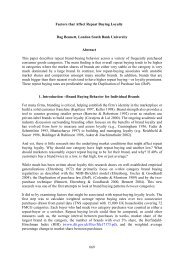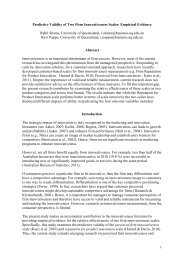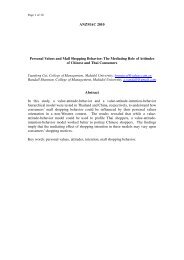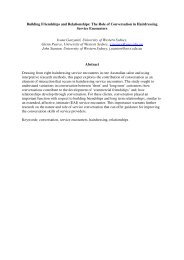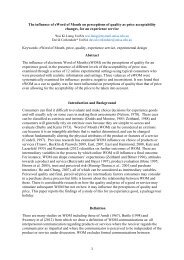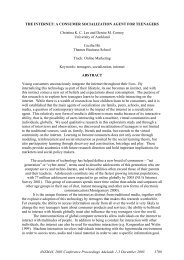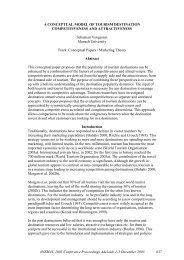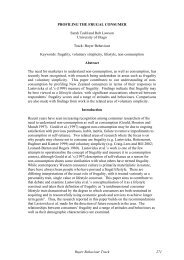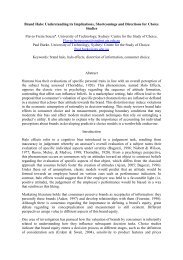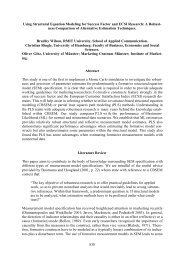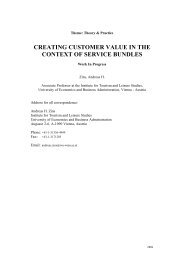improving the potential to forecast demand for wine by ... - ANZMAC
improving the potential to forecast demand for wine by ... - ANZMAC
improving the potential to forecast demand for wine by ... - ANZMAC
Create successful ePaper yourself
Turn your PDF publications into a flip-book with our unique Google optimized e-Paper software.
Un<strong>for</strong>tunately, <strong>the</strong> patterns of <strong>wine</strong> consumption are relatively unknown as <strong>the</strong>re is<br />
little empirical evidence of <strong>the</strong> habits of <strong>wine</strong> consumers. There are two studies on<br />
<strong>the</strong> population’s <strong>wine</strong> consumption habits, from <strong>the</strong> Australian Bureau of Statistics<br />
(ABS) in 1994/5 and 1998, but in isolation, <strong>the</strong>se cross-sectional studies are of little<br />
use in <strong><strong>for</strong>ecast</strong>ing <strong>demand</strong>. However, an argument can be made that if consumers’<br />
his<strong>to</strong>rical patterns of <strong>wine</strong> consumption can be confirmed with data from <strong>the</strong>se two<br />
samples, empirical evidence on <strong>wine</strong> consumption could be generated retrospectively.<br />
Consequently, this study proposes <strong>the</strong> use of a retrospective survey method as a way<br />
of investigating consumers’ <strong>wine</strong> consumption habits over <strong>the</strong>ir lives.<br />
Evidence of retrospective studies in marketing is difficult <strong>to</strong> find. However, <strong>the</strong><br />
process of a retrospective cohort study is well established in <strong>the</strong> field of<br />
epidemiology. This paper suggests <strong>the</strong> his<strong>to</strong>rical consumption patterns of Australians<br />
are investigated using <strong>the</strong> established methodology <strong>for</strong> a retrospective cohort study.<br />
The findings can be tested against <strong>the</strong> data provided <strong>by</strong> <strong>the</strong> ABS in 1994/5 and 1998<br />
<strong>for</strong> validity of <strong>the</strong> study.<br />
This study contributes <strong>to</strong> <strong>the</strong> development of a new methodology <strong>for</strong> validating <strong>the</strong><br />
behaviours of consumers in past periods. Additionally, if consumers can be shown <strong>to</strong><br />
recall <strong>the</strong>ir <strong>wine</strong> consumption patterns, <strong>the</strong>ir patterns of consumption can be<br />
evaluated, and <strong><strong>for</strong>ecast</strong>ing of future consumption can be made with improved<br />
accuracy.<br />
The first section of this paper explains <strong>the</strong> background <strong>to</strong> <strong>demand</strong> <strong><strong>for</strong>ecast</strong>ing and <strong>the</strong><br />
benefits of <strong>the</strong> process <strong>for</strong> industry. The second section highlights <strong>the</strong> in<strong>for</strong>mation<br />
required <strong>for</strong> applying <strong>the</strong> principles of <strong>demand</strong> <strong><strong>for</strong>ecast</strong>ing. The third section outlines<br />
<strong>the</strong> goal of generating empirical data on his<strong>to</strong>rical <strong>wine</strong> consumption. The next<br />
section details <strong>the</strong> methodology used in epidemiology <strong>for</strong> surveying respondents on<br />
<strong>the</strong>ir retrospective behaviours, and how it can be applied <strong>to</strong> this study. The final<br />
section summarises <strong>the</strong> concept of this paper be<strong>for</strong>e suggesting fur<strong>the</strong>r directions <strong>for</strong><br />
this study.<br />
Demand Forecasting<br />
Demand <strong><strong>for</strong>ecast</strong>ing is <strong>the</strong> process of using his<strong>to</strong>rical data on consumption in order <strong>to</strong><br />
anticipate future <strong>demand</strong> <strong>for</strong> a product or service (Smith, Herbig, Milewicz and<br />
Golden 1996; Armstrong 1999). Industries budget <strong>for</strong> <strong>potential</strong> <strong>demand</strong> as a way <strong>to</strong><br />
allocate resources <strong>to</strong> a firm’s operations. However, <strong>to</strong> enable a reliable <strong><strong>for</strong>ecast</strong> of<br />
<strong>demand</strong>, <strong>the</strong> approximate number of consumers and <strong>the</strong>ir probability of consumption<br />
need <strong>to</strong> be known <strong>by</strong> <strong>the</strong> <strong><strong>for</strong>ecast</strong>er (Massy 1969). The problem in <strong>the</strong> <strong>wine</strong> industry<br />
in Australia is that nei<strong>the</strong>r of that in<strong>for</strong>mation is available as <strong>the</strong>re is little data on <strong>the</strong><br />
consumption habits of <strong>the</strong> population.<br />
Applications <strong>to</strong> <strong>the</strong> Wine Industry<br />
To <strong><strong>for</strong>ecast</strong> <strong>demand</strong> in <strong>the</strong> <strong>wine</strong> industry, <strong>the</strong>re are three main options: 1. Assume<br />
that production and consumption occur at <strong>the</strong> same time; 2. Use sales data, assuming<br />
that sales and consumption occur concurrently; or 3. Use actual consumption data.<br />
<strong>ANZMAC</strong> 2003 Conference Proceedings Adelaide 1-3 December 2003 687



